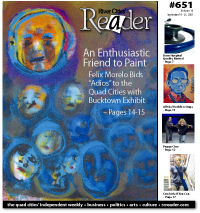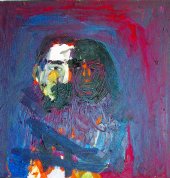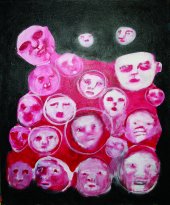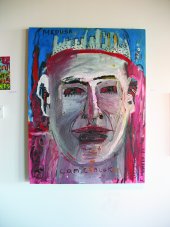 Rarely does paint - the actual physical stuff laden with pigment - have as enthusiastic a friend as it does with Felix Morelo. The artist often lavishes his surfaces with thick and lustrous textured passages in blood reds, dirty aqua greens, or caustic oranges. In other areas, he stingily scrubs in the most minimal hints of browns or soiled denim blues.
Rarely does paint - the actual physical stuff laden with pigment - have as enthusiastic a friend as it does with Felix Morelo. The artist often lavishes his surfaces with thick and lustrous textured passages in blood reds, dirty aqua greens, or caustic oranges. In other areas, he stingily scrubs in the most minimal hints of browns or soiled denim blues.
Regardless of much paint rests on the surface, Morelo's underlying passion for image-making is transmitted through his pieces. His paintings are like a surfer tenuously riding a powerful wave: Sometimes Morelo rides the wave to the shore, and other times he loses control and falls overboard. Either way, it's enjoyable to watch.
Seldom do his color combinations interact with an academic sense of visual harmony. Yet his "outsider" approach to color theory yields some unexpectedly potent and startlingly fresh color interactions. It is these "unsanctioned" triumphs that make this show such a treat.
My 2 Cents showcases Morelo's recent oil and acrylic paintings, drawings, suspended painted constructions, and intricate mixed-media boxes, all completed within the past few years. At well over 200 pieces, the exhibit is a robust exploration of one of this area's more prolific image-makers. It fills a 3,000-square-foot fourth-floor riverview loft condo inside the Bucktown Center for the Arts. (The unnocupied former warehouse space is owned by River Cities' Reader founders Todd McGreevy and Kathleen McCarthy.)
 The show is as a chance for Morelo to say goodbye to the Quad Cities community. Shortly after the exhibit closes, he and artist Ana Moore plan to move to Mexico.
The show is as a chance for Morelo to say goodbye to the Quad Cities community. Shortly after the exhibit closes, he and artist Ana Moore plan to move to Mexico.
The sheer volume of works in My 2 Cents is a double-edged sword, to be sure. The close proximity of so many of Morelo's pieces allows them to inform and interact with each other in ways they might not otherwise. However, it also prevents many of the works from receiving the proper amount of space they need to shine as individual entities.
Those who have followed the development of Morelo's work (I have been in several shows with him, including a three-person exhibit at Quad City Arts in 2005) will know that his stunning and intimate boxes are colorful and packed with text, pigment, and additions such as plastic army men and doll parts. They are like three-dimensional visual diaries, and each box is a full page of the artist's ideas and experiences. Because you cannot see all of the sides simultaneously, you are required to physically move from facet to facet to fully experience each work. Morelo's boxes benefit from a large and dense display (the more the merrier) but here are scattered on several columns and almost feel like an afterthought to the works on canvas and on paper.
The oil-on-canvas painting Medusa Stare is a strong example of how Morelo's untamed use of color works. The piece is dominated by a large androgynous face sculpted from thick swaths of warm grays and muted purples. The commanding yet malproportioned face is wreathed with cadmium reds and pinks that meld into facial forms toward the bottom of the picture plane. The fiery mass of gestural hair is crowned with a small cityscape of high rises, which are painted in more neutral tones and set off by small patch of cool blue in the background.
The sharp contrast between the warm tones of the figure and the minimal yet crisp and cool blue background gives emphasis to the band of more neutral-colored buildings caught in between. The structures become an extension of Medusa's poisonous snake hair.
One of the best examples of color combinations that shouldn't work but do is Morelo's oil-on-canvas piece Becoming. Unlike his many impasto-like handlings of paint, Becoming is one of several works where the paint is applied thinly. In some places it is almost more of a color wash or stain than painted.
 Morelo utilizes some fairly simple yet effective visual dialogs. Becoming is populated with circular face forms with varying levels of descriptive detail. The playful variations found within the circles and ovals help direct the viewer's attention around the composition. This motion is balanced by the back-and-forth between the baby-poop ochre of the background and the robust darker blues and purples of the circular forms. This cultivates a surprising interaction with the few faces that have just enough cool whites and greens to offset them.
Morelo utilizes some fairly simple yet effective visual dialogs. Becoming is populated with circular face forms with varying levels of descriptive detail. The playful variations found within the circles and ovals help direct the viewer's attention around the composition. This motion is balanced by the back-and-forth between the baby-poop ochre of the background and the robust darker blues and purples of the circular forms. This cultivates a surprising interaction with the few faces that have just enough cool whites and greens to offset them.
The payoff is found with the luminous orange and yellow face toward the upper-left corner. It contains the most descriptive brushwork, and its warmth and detail are a stark contrast to the cooler implied forms surrounding it.
Two interpretations leap to mind when contemplating Becoming. The first is the notion of conception. The cool, barely defined ovals are unfertilized eggs in the womb - the life that will never be - while the larger and more-detailed orange facial disc is a growing embryo.
The other interpretation is concerned with awareness and enlightenment. Here, the cool ovals become the identity-less masses scuttling about, burning through another day in their unexamined lives. The warmer shapes express a sense of purpose and individuality. The most specifically described face is glowing from what could be deemed self-examination and wisdom. The cooler and darker colors also cause this "enlightened" face to become a beacon to the other shapes lost in the dark.
Embrace is an example of the paint spiraling out of Morelo's control. Nearly smack-dab in the center of the piece are two melding figures, one male and one female. The comparatively detailed face of the male is a disproportionately small island of white and light grays surrounded by a sea of muddled reds and purples. The female portion of the pair is nearly dissolved into the monotone morass of red. "She" is not presented with the same level of visual clarity and importance as the male, and becomes lost in the mix. Without the female portion providing balance, the fragile patch of lighter tones can't hold its own, and the piece becomes too asymmetrical to function properly.
Morelo could be tapping into the misogynistic Picassonian fears of castration and suffocation by having the female form so thoroughly overtake the male. Yet the two interlocked figures seem to reference the yin/yang symbol, which would imply a kind of visual and spiritual equity between them. In that interpretation, the actual visual importance they carry contradicts the theoretical role they were to assume.
 But to only talk about how Morelo succeeds or fails in applying pigment to surfaces does little justice to the exhibition. The risks that the artist takes, such as his unconventional compositions and his willingness to add collage elements in passages that don't readily suggest collage, are rewarding by themselves. His pieces build their foundations at the intersection of big-city, east-coast American culture, Latin American culture, and some of Morelo's personal mythologies.
But to only talk about how Morelo succeeds or fails in applying pigment to surfaces does little justice to the exhibition. The risks that the artist takes, such as his unconventional compositions and his willingness to add collage elements in passages that don't readily suggest collage, are rewarding by themselves. His pieces build their foundations at the intersection of big-city, east-coast American culture, Latin American culture, and some of Morelo's personal mythologies.
Morelo's works are often rich with questions and sparse with the answers. The value lies in questioning what you see, versus knowing what is going on.
A good example is the surrealistic landscape Buffalo, which gives a glimpse into a world with swirling forms and partial figures traveling through Morelo's idiosyncratic narrative. There is a figure near the bottom of the picture, half-submerged in a tumultuous swirling mass of greens. Above its head is a mouth-like oval attached to a bloated pink tube, which becomes part of a larger beast/machine form. Is the figure about to be plucked from the goo and consumed, or did it just get spat out by the beast? Could the oval actually be a halo or some kind of tranquil grotto of the mind, and not a gaping maw at all? Ambiguity holds far more intrigue than the didactic.
The process of trying to decode Morelo's works is an adventurous and worthwhile undertaking. His ability to reference source material from several cultures and languages increases the challenge of deciphering, but also heightens the rewards of understanding.
My 2 Cents will be open from 1 to 4 p.m. on September 22 and 29. A closing reception will be held from 7 to 9 p.m. during Bucktown's "Final Friday" event on September 28.








